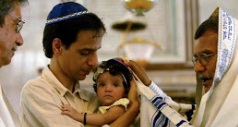This article will describe in detail all the procedures of a typical Bene Israel Family preparing for and celebrating the Festival of Passover celebrated from “טו to כא” of the Hebrew Calendar Month of Nisan. It should be noted that in the Diaspora the Bene Israel celebrate two days of the Seder. In early 20th Century each family did two days of service at home, but later on it became common practice to perform the first night in the Family and the second night as a community. This permitted interaction between community members and bonding. As common in all Jewish Families preparations start with a general house cleaning and putting away all winter clothes and linen. The next item on the list is the preparation of the Matzoth for the Passover week. In days gone by these Matzoth were prepared at home by the women of the house for the whole week of Passover & beyond. Each family prepared around about one hundred Matzoth or more depending upon the size of the family.
In order to achieve this task in the earlier days when there existed the Joint Family system the women of the house cooperated in making the matzoth but with the advent of the twentieth century and advent of the single family units it became essential that several women generally sisters & sisters in laws would cooperate and go to each of the houses over the ten day period prior to Passover and help that family to make their requirement of Matzoth. It was very admirable to see the women working together, joking and generally enjoying themselves whilst fulfilling and performing each, their allotted task. For the Recipe of making the Matza and other Seder items and food for the Passover week see the recipes section at the end of this article. Note three special Matza were made for the Seder each one in order marked with one or two or three small extensions to mark the Cohen Levi & Israel Matza. On the night before Passover, all the Hametz (leavened bread) would be removed from the house.
Note the Bene Israel would completely remove all the Hametz from the house and not as in Ashkenazi tradition or in the tradition of some other Jewish communities that the Hametz would be sold to a goy and then still be kept in the house. After this all the special vessels, dishes and plates used only for Passover would be taken out. These and other dishes would then be dipped in hot and cold water to purify (Kosher) them once again for use in the Passover week. Other vessels were put away in a separate locker. Further during the Passover week no dried red Masala would be used. During this week only fresh green Masala would be used as spices for the food.
A day or so prior to Passover the family would purchase all the special items for the Passover Seder. Two items were specifically made for the Seder, Kiddush wine out of Black Currants and Shira (Haroset). Shira or Haroset was made by each family which made the Seder (for the recipes see below). For the Shira there are many recipes, the recipe given below is that of The Moses Family. The Shank Bone (Zerovah) is prepared from the right fore leg of a goat or sheep only. Some communities use chicken bone but this the Bene Israel consider as an unacceptable alternative for the Seder Service.
For, recipes see below.
Two items were specifically purchased one-an earthen ware clay pot and second-a cheap small wine glass. These were used by the reader for reciting the plague and dropping the wine into the clay pot. The Bene Israel and most oriental Jews never dropped the wine, each from his cup into his plate as done by some communities. These were plagues and that was meant for the Egyptians. When this was being performed by the reader, all other glasses, plates and the Seder Plate were removed from the table or covered.
An important part of Bene Israel Tradition was & is that the first born son of all families would fast from early morning till the Seder service on the eve of Passover.
Noah Masil informed the author of a specific Bene Israel tradition especially in the villages and small towns of the West Coast of India. Families performing the Seder would slaughter a goat for the Passover meal. As soon as the goat was slaughtered the blood would be hand palm imprinted on the door of every Bene Israel house in that area. Later on, the imprint of the Hand was made on paper and each family would post this on their door as was done by the ancestors of the Hebrews on the night of the Passover.
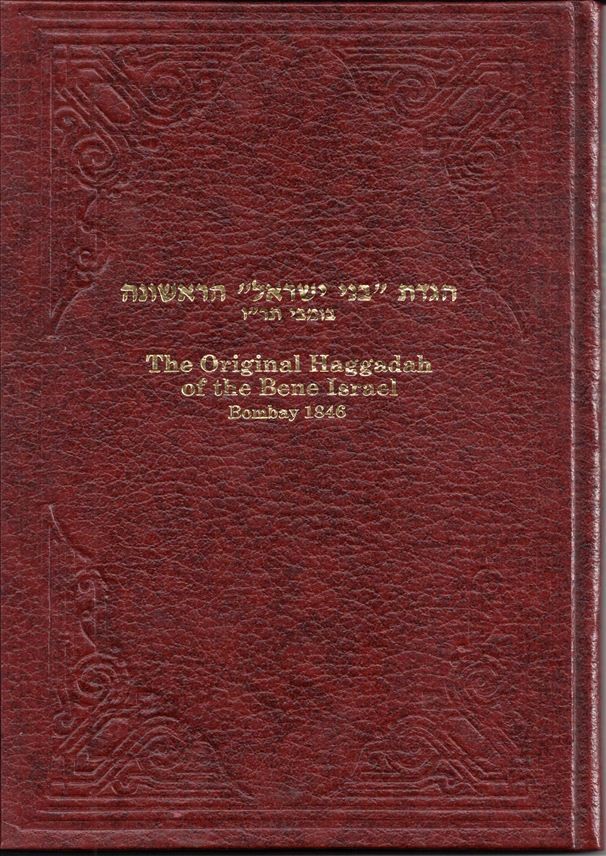
The Original Bene Israel Haggadah Published in 1848
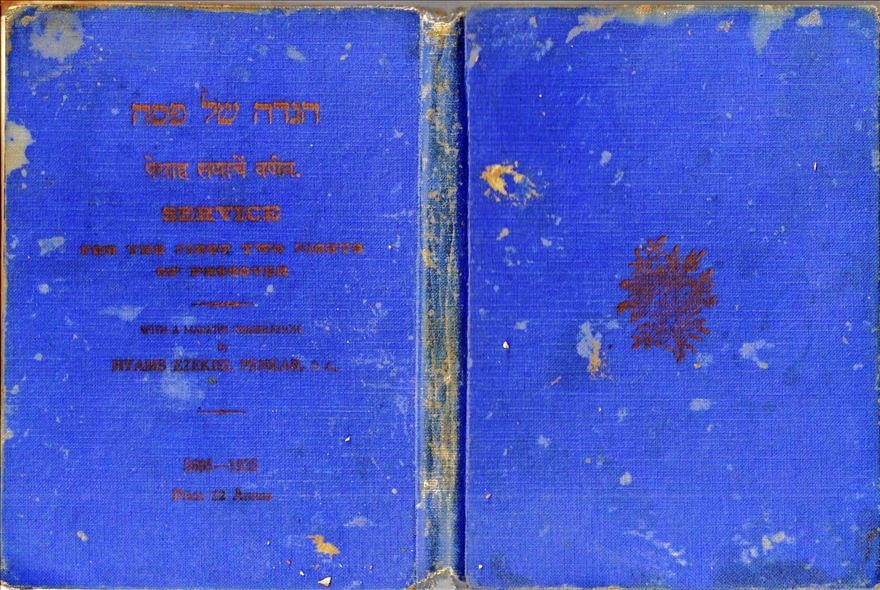
The Haggadah Published by Hyam Ezekiel Penkar in 1895
Digitized Copy of these antique Haggadahs are in the Collection of Nissim & Beatrice Moses
Above Haggadah Pictures Courtesy of Mr. Noah & Ms. Sybia Masil
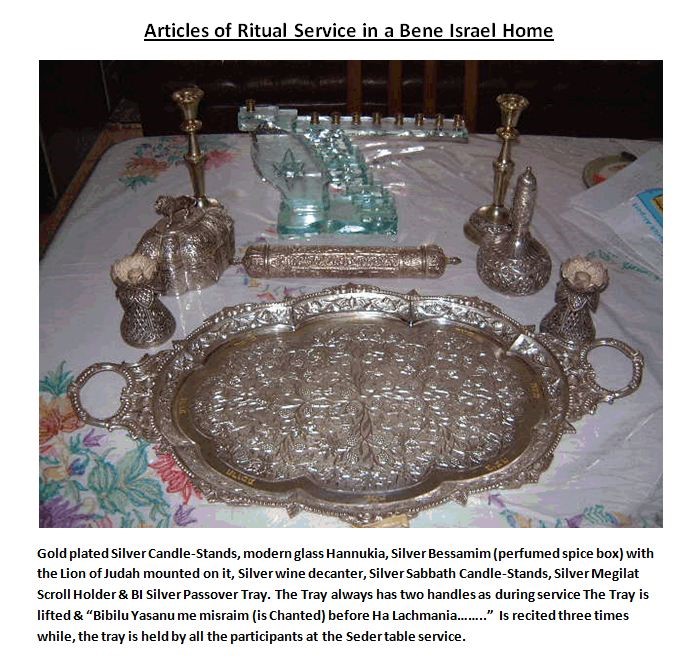
A Typical Bene Israel Passover Tray/Plate among other Bene Israel Religious Artifacts.
Note the two handles on the tray-this was to give stability to the tray during the lifting and rocking the Plate while Reciting “Bibilu Yasanu Me Misraiim, Ha Lachmania….”
The Seder Plate Consisted of:
- The Zerovah-(The Shank Bone)
- The Matzoth (3 in number in separate compartments in a bag)
- The Haroset (Shira)
- The Lemon Juice
- The Eggs
- The Celery (Karpas)
- The Maror (Salad/ lettuce leaves)
- A small bowl of Salt
The basic Seder service is traditionally very similar to that of other Jews elsewhere, with the exception of the following. Prior to the Passage of Ha Lachmania there is a line Starting with “Bibilu Yasanu Me Mitzaraim Ha Lachmania….” The Seder Plate is held by all and lifted and rocked while chanting this passage. At the end of the reading of this passage the plate is set down. This is repeat three times after which the traditionl questions of Manish Tana are asked by the youngest in the Family. The rest of the service continues as already mentioned except again for the reciting of the plagues which is performed as explained earlier. After the formal Seder service the festive meal is eaten and the rest of the service–grace after meal is recited.
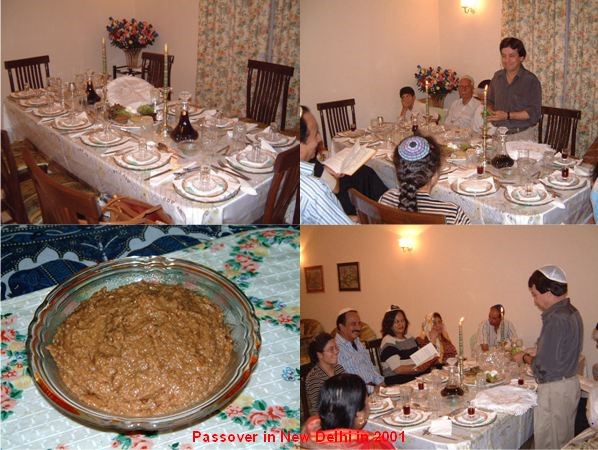
The Passover Service at the Residence of the Moses Family in New Delhi
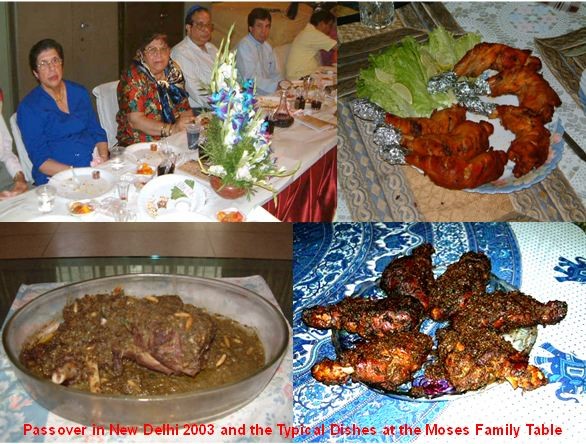
The Communal Passover Organized By the Moses Family
Recipes:
Rice (Chappatis) Bread-for Passover
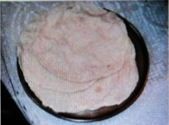
Ingredients:
- Two (2) Cups of Rice Flour Sieved
- Two (2) Cups of Water
- Half (0.5) a Cup of Extra Water
- Half (0,5) a Teaspoon of Salt
- One (1) Tablespoon of Olive Oil
Method:
Mix the 2 cups of water with the oil and salt and let it boil. Add rice flour and stir the mixture well and let it heat on the stove on low heat. Stir a couple of times while heating. Cover the pot and continue heating for 2-3 minutes. When the lid is taken off the steam will puff out. After removing from the stove again close the pot and let it cool for a few minutes about 3 minutes. Then pour the mixture onto a large pan (Thala) and knead well with the oil; breaking any lumps of the mixture; into a dough and keep covered for a few minutes (about 5 minutes). Then before making the chappatis knead again with the extra half cup of water and divide the dough into 16-18 balls of dough. Roll each ball into a thin chappati and dry fry/bake it on a flat cast iron plate (called a Tava-see picture below in Matza section ). Eat hot or store wrapped in a thick cloth to keep warm. Very tasty bread especially with meat dishes and gravy.
Kiddush Wine
Ingredients:
- A quarter (0.25) Kilogram Black Currants
- Two - Three (2-3) Glasses of Water
Method:
Add the water to the currants and let it soak overnight. The next day boil the water with the black currants in them. The currants will bloat. When the water cools, squeeze the juice out of the currants with gloved hands, or with a mixer. Add about 1.5 glasses of water a little at a time but the final mixture should be sweet & not insipid. Then strain the mixture with a fine clean cloth. Pour the juice into a jug or a bottle and keep in the fridge for a few hours. This makes excellent Kiddush wine.
Shira or Haroset For Passover
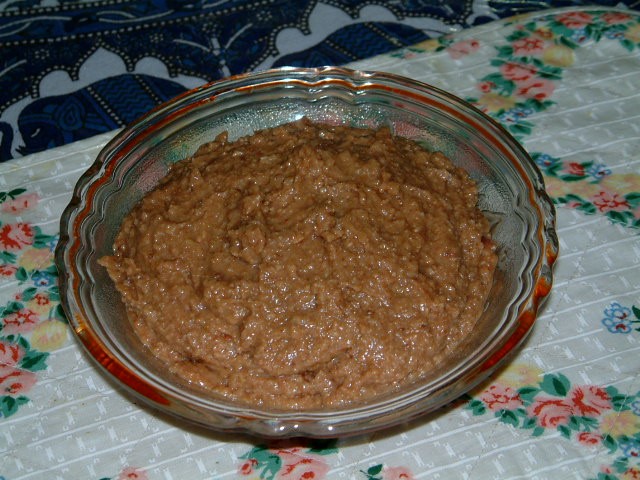
Ingredients:
- One (1) Kilogram of Pitted Dates
- One hundred (100) Grams of each Almond, Sweet Walnuts, Pistachios, Cashew nuts, Charoli nuts, White and Black currants all ground into a paste in a grinder.
- Three (3) Liters of Red Grape Juice
- Two (2) Liters of Red Kiddush Wine
- One (1) Cup of Dry Red Wine (Kosher for passover)
Method:
Mix all the above ingredients well and boil the mixture for about 40-50 minutes to thick paste. When cool, the paste may be bottled and may be kept in the fridge and used all year round as a sandwich spread on Matza during Passover) or bread (after Passover)
Matzah Bread
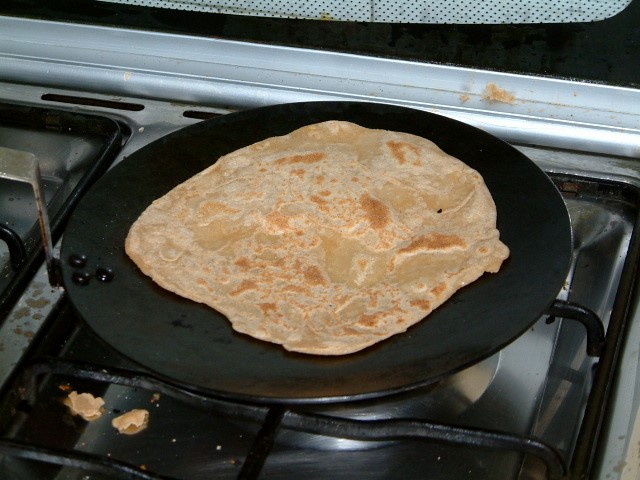
Ingredients:
- Two (2) Cups of Matzah Flour
- A Quarter (0.25) Teaspoon of Salt
- One (1) Cup of Water
- Half (0.5) a Cup of Extra Flour for coating while rolling/flattening the dough into chappati thin circular bread
- One (1) Wire Brush
Method:
Mix the flour, salt and water and knead into a firm dough. Do not keep. Immediately break the dough into small balls and roll each ball into a thin flat chappati. During the rolling process use the extra flour mentioned above. While rolling, flip the chappati over from side to side while dipping or spreading the extra flour. The immediately fry. Roast on a flat cast iron Tava. While roasting and when the chappati is still wet give a few taps with the wire brush so the Matza Chappati does not puff up. When cooked it is crisp, take it off the Tava and let it cool.
All the Matza bread are made prior to the Passover week some families make about 100 of them and then place all the Matza Bread in a Huge white Bed sheet tying the four corners together to form a sort of bag, which is then hung from the ceiling in one of the rooms. The Matza bread are then used during the Passover week.
Shank Bone- (Zerovah)
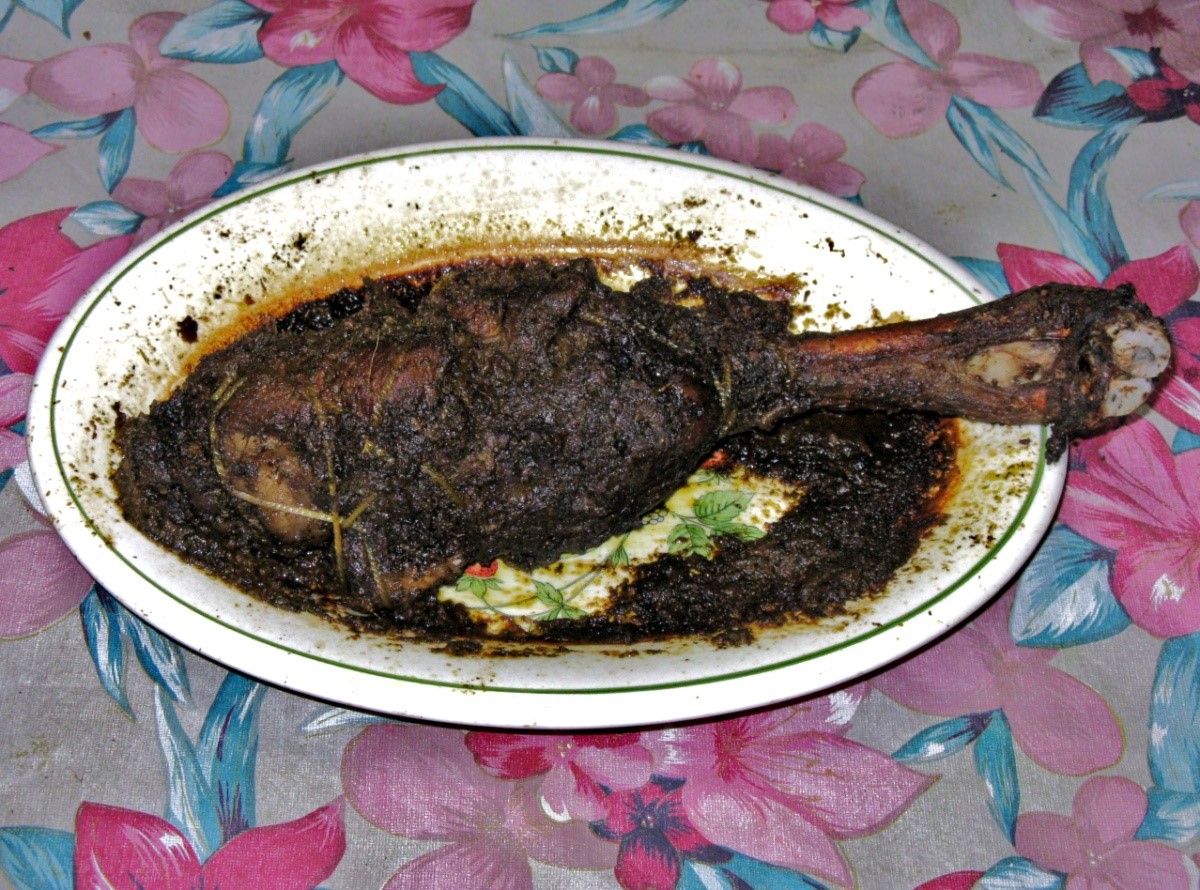
Pepper Mutton or Pepper Liver (Lamb Shank Bone-for Passover made absolutely dry)
Ingredients:
- Half (0.5) Kilogram of Mutton or Liver or One (1) Shank Bone
- Two (2) Fine chopped Onions
- One (1) Teaspoon of Pepper Powder
- Half (0.5) a Teaspoon of Ginger Powder
- Six (6) Garlic Cloves
- Half (0.5) a Teaspoon of Turmeric
- One (1) Teaspoon of Salt
Method:
Pour 4-tablespoon olive oil into a pot, then add onions. Fry red. Add the spices given above and stir the fry. When the fry gravy is nice and thick. Let it cool. In parallel pre-cook the Shank bone in a pressure cooker till the meat is tender but not over cooked it should be slightly under cooked. Apply the prepared spice mix to the shank bone. Now wrap the shank bone in baking paper and then in loosely wrapped Aluminum foil and let it absorb the marinate for about 1 hour. Pre heat the oven to 275 degrees centigrade for 15 minutes. Now put in the Shank bone wrapped in aluminum foil in the oven for 20 minutes under heat. After 20 minutes keep the shank bone as is in the oven but switch the heat off. After 20 minutes, turn on the heat again for twenty minutes. After twenty minutes again turn off the heat but let the shank bone remain in the oven. When it is cool, remove both the wrappings and wrap ready shank bone in nylon foil to be placed in the Seder Plate. Covered in nylon wrapping it will not stain the other decorative covers of the Seder Plate. Special note-To get enough meat on the shank bone remove the meat from the Shoulder blade above the shank bone without disconnecting from the shank bone but removing the shoulder blade bone. Wrap this meat around the top of the shank bone and cook as above.
By
Nissim Moses-Hon. President
Bene Israel Heritage Museum & Genealogical Research Center



